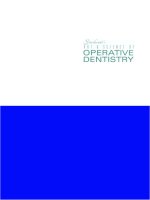Test bank for auditing the art and science of assurance engagements 11th canadian edition
Bạn đang xem bản rút gọn của tài liệu. Xem và tải ngay bản đầy đủ của tài liệu tại đây (114.17 KB, 12 trang )
Test Bank for Auditing The Art and Science of Assurance
Engagements 11th Canadian Edition
In the audit of historical financial statements by PA firms, the criteria used
are
1. A) regulations of the provincial securities commissions.
2. B) regulations of the Canada Revenue Agency.
3. C) generally accepted auditing standards.
4. D) generally accepted accounting principles.
Auditing should be done by
1. A) a chartered accountant.
2. B) a competent and independent person.
3. C) a professional accountant.
4. D) a certified management accountant.
A large PA firm has assessed evidence collected during an engagement.
Criteria used to assess the financial statements were generally accepted
accounting principles. A high level of assurance was obtained. The type of
engagement conducted was:
1. A) compilation
2. B) review
3. C) audit
4. D) management consulting
George had a conversation with the accounting personnel and documented
information about how the accounting systems function. He has also placed
copies of accounting forms in his files. George is performing which task?
1. A) tax audit
2. B) accounting procedures
3. C) audit report preparation
4. D) evidence gathering
The auditor and the entities should agree on the criteria to be used in the
audit
1. A) at the end of the audit.
2. B) before the audit starts.
3. C) after the audit planning has been done.
4. D) as they progress with the audit as they can determine which criteria is
more suitable.
Because an external auditor is paid a fee by a client company, he or she
1. A) is absolutely independent and may conduct an audit.
2. B) must receive approval of the relevant provincial securities commission
before conducting an audit.
3. C) is never considered to be independent.
4. D) may be sufficiently independent to conduct an audit.
It is important for the auditor to be independent because
1. A) the auditor would not charge a fair rate to the client.
2. B) the audit conclusions cannot be relied upon if the auditor was biased in
accumulating and evaluating evidence.
3. C) the auditor might not be as knowledgeable of the subject matter and the
criteria.
4. D) the Canadian Tax Authorities require that the auditor be independent.
The auditorʹs report is
1. A) the set of audited financial statements.
2. B) the report presented to management about the possible improvements.
3. C) the communication of audit findings to users.
4. D) the invoice of the auditor detailing the work they have performed.
In the audit of an individualʹs tax return, the criteria used would be
1. A) the auditorʹs judgement.
2. B) the clientʹs policies for taxable income.
3. C) the Income Tax Act.
4. D) GAAP.
Joe is recording sales transactions in the accounting system so that they can
be summarized in a logical manner for the purpose of providing financial
information for decision-making. Joe is doing
1. A) review.
2. B) management consulting.
3. C) auditing.
4. D) accounting.
In ʺauditingʺ accounting data, the concern is with
1. A) determining if fraud has occurred.
2. B) determining whether recorded information properly reflects the economic
events that occurred during the accounting period.
3. C) determining if taxable income has been calculated correctly.
4. D) analyzing the financial information to be sure that it complies with
government requirements.
What type of organizations use auditing services?
1. A) Non-for-profit organizations
2. B) Governments
3. C) Businesses
4. D) All of the above
An accountant records information. When conducting an audit, the
distinguishing abilities are the
1. A) accumulation and interpretation of evidence.
2. B) organize and summarize economic events.
3. C) requirement to possess education beyond the bachelorʹs degree.
4. D) ability to interpret generally accepted accounting principles.
In Canada, publicly traded company
1. A) are not required to have an audit if they have a review.
2. B) are required to have audits.
3. C) are strongly encouraged to have audits.
4. D) are not required to have an audit.
A shareholder of a public Canadian firm can have access to the audited
financial statements
1. A) on the internet.
2. B) if he holds more than 1% of the shares of the company.
3. C) requesting a copy from the auditors.
4. D) by calling the accounting department of the company.
A reason for private companies to be audited is
1. A) facilitating access to capital.
2. B) ensuring that their financial statement do not contain errors.
3. C) having a professional accountant perform their bookkeeping.
4. D) complying with the laws requiring them to be audited.
The Sarbanes‐Oxley Act requires the auditor to attest to
1. A) the accuracy of the financial statements.
2. B) the effectiveness of internal controls.
3. C) the compliance of the company with the generally accepted accounting
principles.
4. D) the efficiency of the internal controls in financial reporting.
There is an increasing demand for assurance about computer controls
surrounding financial information transacted electronically and the security of
the information related to the transaction. This is in large part due to
1. A) the many transactions and information shared online and in real time by
companies.
2. B) clientʹs uncertainty about the proper functioning of their computer system.
3. C) the increasing presence of internet sales in many businesses.
4. D) the use of computer assisted auditing tools.
The WebTrust principle of processing integrity refers to
1. A) providing assurance that the transactions are processed completely and
accurately.
2. B) providing assurance that access to the system and data is restricted to
authorized individuals.
3. C) providing assurance that the information designated as confidential is
protected.
4. D) providing assurance that the systems and data will be available to the
users when they need it.
The WebTrust principle of security refers to
1. A) providing assurance that access to the system and data is restricted to
authorized individuals.
2. B) provides assurance that the information designated as confidential is
protected.
3. C) providing assurance that the transactions are processed are completely
and accurately.
4. D) providing assurance that the systems and data will be available to the
users when they need it.
The auditor must have a thorough understanding of the entity and its
environment. The auditor must also consider the clientʹs business strategies,
processes, and measurement indicators for critical success factors related to
those strategies. This analysis helps the auditor
1. A) decide if they want to accept the engagement.
2. B) assess the level of materiality that is appropriate for the audit.
3. C) identify risks associated with the clientʹs strategy that could affect the
financial statements.
4. D) identify the potential for fraud in the financial reporting process.
Blader Ng. Inc. has recently placed into production new air-cleaning systems
in their smoke-stacks to meet clean-air quality regulations. PA has been
engaged to assess air quality and compare results to legislated requirements.
What type of audit or engagement is PA conducting?
1. A) financial statement
2. B) operational
3. C) compliance
4. D) review
A review of any part of an organizationʹs procedures and methods for the
purpose of evaluating efficiency and effectiveness is classified as a(n)
1. A) compliance audit.
2. B) production audit.
3. C) audit of financial statements.
4. D) operational audit.
Which one of the following is more difficult to evaluate objectively?
1. A) compliance with government regulations
2. B) efficiency and effectiveness of operations
3. C) presentation of financial statements in accordance with Canadian
generally accepted accounting principles
4. D) All three of the above are equally difficult.
A typical objective of an operational audit is for the auditor to
1. A) make recommendations for improving performance.
2. B) report on the entityʹs relative success in attaining profit maximization.
3. C) evaluate the feasibility of attaining the entityʹs operational objectives.
4. D) determine whether the financial statements fairly present the entityʹs
operations.
Which of the following audits can be regarded as being solely ʺcomplianceʺ
audits?
1. A) an internal auditorʹs review of his employerʹs payroll authorization
procedures
2. B) the Auditor Generalʹs evaluation of the computer operations of
governmental units
3. C) Canada Revenue Agencyʹs examinations of the returns of taxpayers
4. D) a public accounting firmʹs audit of the local school district
The predominant type of assurance service performed by large public
accounting firms is
1. A) review.
2. B) audit.
3. C) management consulting.
4. D) compilation.
The No-Name Advertising Rating Agency conducts independent surveys to
determine the sources of purchases by consumers (e.g. newspaper ad,
magazine ad, television ad). This information is then used by those media
(i.e. newspapers, magazines, and television broadcasters) to indicate to
purchasers of advertising the breadth of coverage that they have. For
example, Small Local Newspaper can say that 10% of the purchasers of soap
products made their decisions based upon their ads. This helps in selling
advertising. What type of service is No-Name providing?
1. A) Compilation
2. B) Attest
3. C) Review
4. D) Assurance
Which of the following services provides a moderate level of assurance about
the clientʹs financial statements?
1. A) Audit
2. B) Forecasts and projections
3. C) Compliance
4. D) Review
PA is attempting to sell a service to his clients that will provide assurance on
information systems reliability. PA is attempting to sell a(n):
1. A) SysTrust service
2. B) WebTrust service
3. C) audit engagement
4. D) compilation service
Which of the following services provides no assurance about the clientʹs
financial statements?
1. A) compilation
2. B) audit
3. C) review
4. D) None of the above; they all provide some level of assurance.
Herbert Zora is having financial statements prepared by his PA to accompany
his tax return. His primary concern is cost. Of the following, the lowest cost
engagement that the PA can perform for Zoraʹs financial statements is:
1. A) review
2. B) WebTrust
3. C) audit
4. D) compilation
Auditors General are responsible for auditing which types of
organizations?
1. A) Any organization that submits tax returns to the tax authorities
2. B) Ministries, departments, agencies, and crown corporations
3. C) Public companies with shares issued to investors
4. D) Private companies that have loans outstanding to banks or other creditors
In Canada, the two bodies whose members perform most of the attest audits
are the
1. A) CIA and CICA.
2. B) SMAC and CICA.
3. C) SMAC and CGAAC.
4. D) CICA and CGAAC.
External auditors (PAs) can obtain professional experience to satisfy the
requirements of their professional designation at which of the following
organizations?
1. A) Public accounting firms or auditor general offices
2. B) Internal audit departments of large organizations
3. C) Any type of business that has accounting personnel
4. D) Public accounting firms of various sizes only
To operate effectively, an internal auditor must be independent of
1. A) the employer-employee relationship which exists for other employees in
the organization.
2. B) the entity.
3. C) the line functions of the organizations.
4. D) all of the above.
The internal auditor typically reports directly to
1. A) the audit committee and the board of director.
2. B) the management of the company.
3. C) the board of director and the external auditor
4. D) the audit committee and the management of the company.




![clout [electronic resource] the art and science of influential web content](https://media.store123doc.com/images/document/14/y/uo/medium_mc2EvW4pIk.jpg)




